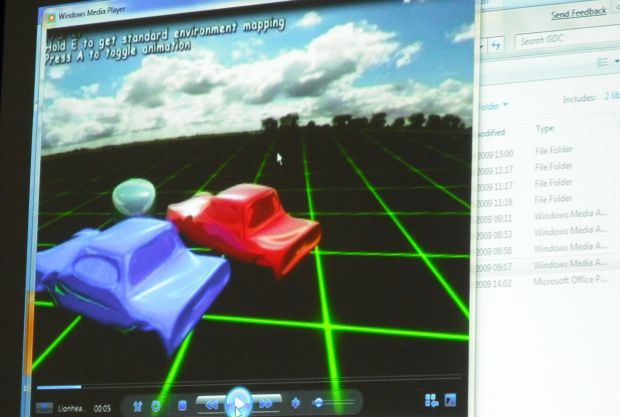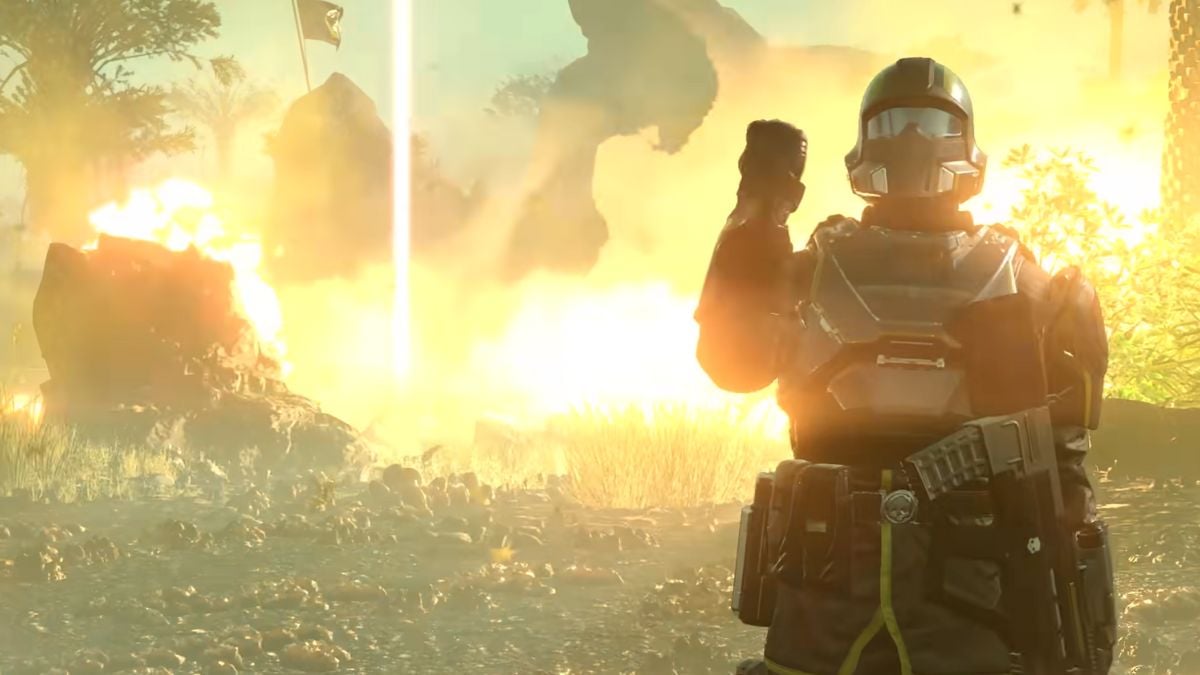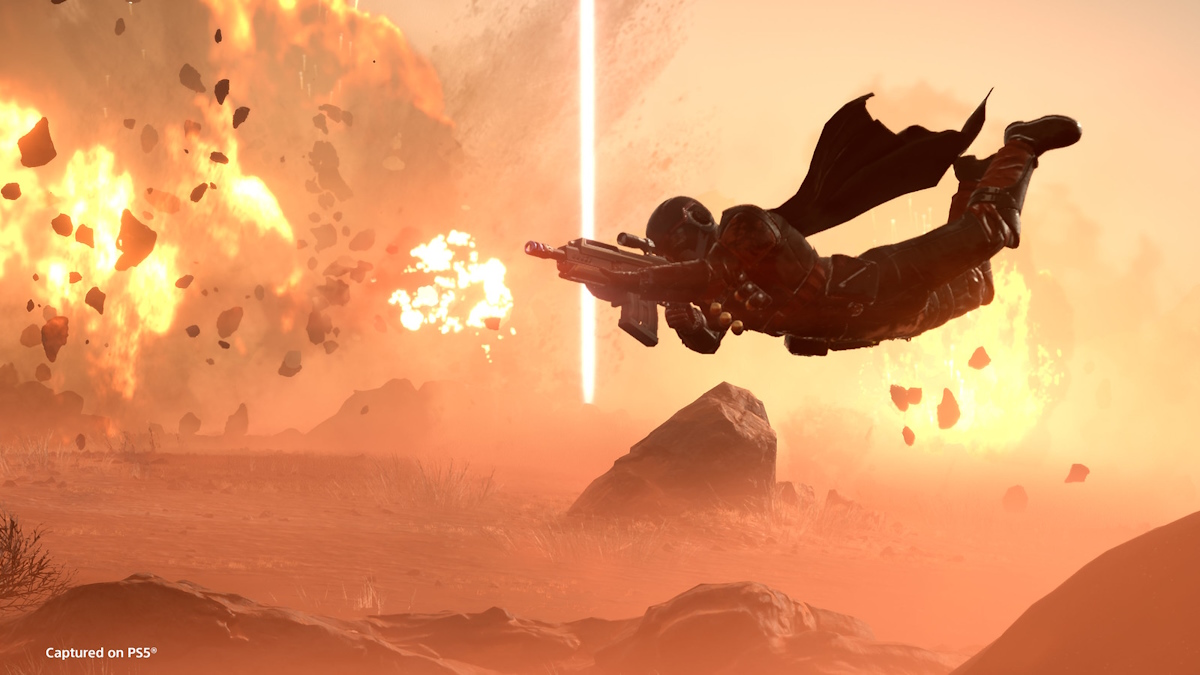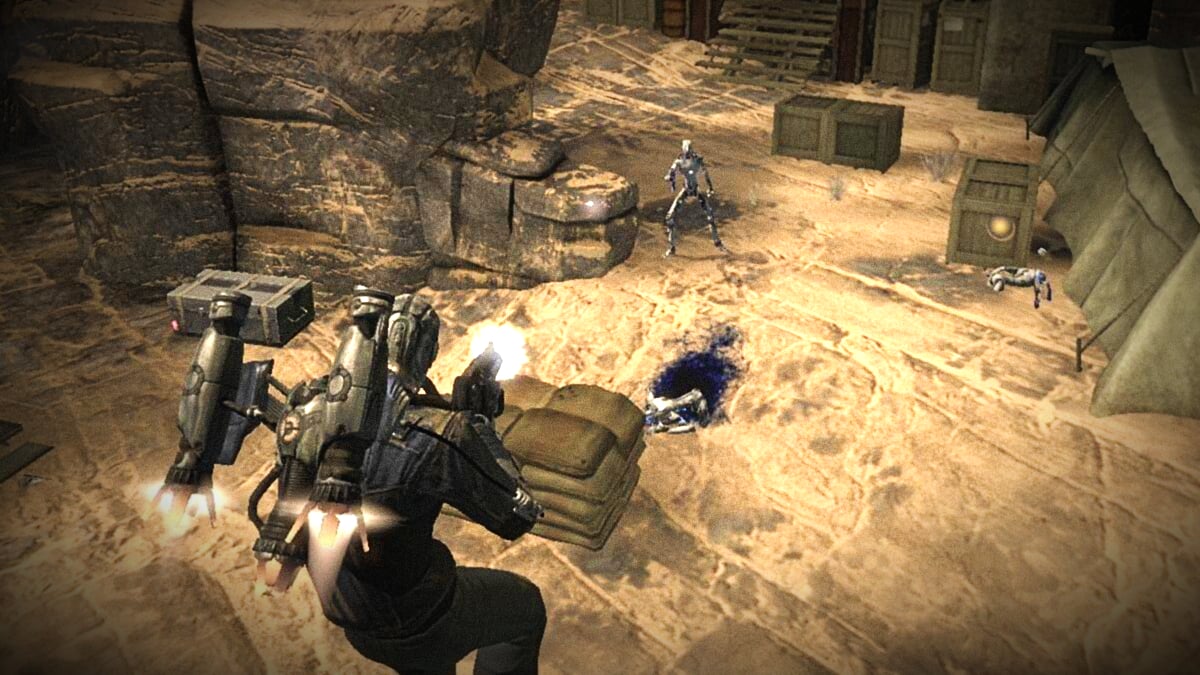No time for clever introductions. Every once in a while Lionhead Studios creates a bunch of experimental videos and demos to test out new design ideas, and this year Peter Molyneux decided to show them off at GDC.
Want to know who came up with portals before Portal? Want to know the genesis of Fable 2‘s one-button combat system?
I’ll pretend you, do for the sake of argument. Hit the jump for a rundown of Molyneux’s presentation.
“You’d think after all these years it’d be easy but I really feel quite nervous,” Molyneux opened with. He launched into an explanation of why Lionhead even bothers to experiment. Molyneux explained that Lionhead, borne out of a drunken night with fellow developer friends, was originally (and drunkenly) intended to innovate and take risks that other people won’t. Lionhead started with Black and White, but “it was utter and complete chaos…maybe because some idiot named Peter Molyneux kept leaping in like Tigger saying ‘I’ve got an idea, let’s do this.’” This resulted in great stuff like the creatures, but also really “dumb and stupid” stuff like an idea he had at an earlier GDC while talking to a journalist. “Hey, why don’t we make…the weather inside Black and White the same as the weather outside in your garden, in the real world.” He told his programmers, they made 10,000 weather site downloads and while they were doing that they weren’t actually working on the game – “it was just a dumb and stupid idea and it derailed the game for a little while.” These experiments came from the lesson he learned from that mistake; experiment first so you don’t try to implement something that takes a lot of time and resources and that you might not even use.
That said, Molyneux believes that what gamers really want is innovation, and thus innovation should still be attempted in the relatively risk-free environments of these experiments. It was easy at the beginning of Lionhead to experiment because the small staff allowed for such changes, but huge teams like Fable‘s aren’t well-suited to that.
Not just designers have the good ideas – programmers and artists and so on typically have great ideas but they have no real forum to express their creativity so they often just leave the company with these awesome ideas. Experimentation helps encourage inhouse creativity.
All the innovations in Fable 2 – the dog, the breadcrumb trail – came out of these sorts of experiments.
What are Lionhead experiments? They’re a fast way of prototyping risky ideas from team members, they’re short-term problems with 1-5 team workers on them at any given moment, they tend to take place at the end of a project when the team members are free, and they can last anywhere between one to twelve weeks with the average of about a month.
How are they structured? Any member of the staff can propose an experiment after getting a sponsor from a senior member of the staff. The sponsor sells the idea to the Lionhead creative board made up of about eight (mostly senior) Lionhead members who meet once every three months and go through all the propositions for all the experiments. “So it’s not as free and as loose that anyone can start experimenting with anything straight away.” Those experiments are then voted on and the top two or three (given time) are put into the experimental process with their own milestones and checkpoints.
After coming back with the experiment, the creative board asks many questions: Why this experiment? What does it add, and what does it cost? How often will it be seen in the game? How do you teach it to the player?

Lionhead has a prototype engine for experimentation that strips away all unnecessary code that’s even useful for “laymen coders” or scripters who aren’t spectacular programmers. One version of one such engine could be entirely compiled into one file. Additionally, experimenters will use existing game engines from, say, Fable or Black and White to get around the initial phase of feeling something doesn’t look pretty or interesting enough. Assets are shared between experiments through a framework called “concrete,” which, ideally, allows asset transfers from different game. “Why shouldn’t you be able to –literally – pick up a tree from Black and White and put it into Fable” to make a full game in 48 hours? It’s still “an absolute dream” at this point, but Lionhead is still working toward it.
After the experiment is done, it’s fully risk-assessed and, if approved, is implemented into the game.
Molyneux briefly opened himself up to questions before moving onto the experiment showcases. One audience member asked if Lionhead restricted itself to Lionhead-only aspects for these experiments. Molyneux said that Lionhead used assets from everything in order to get to the core of an experiment more quickly.
What did Molyneux mean when he referred to “the end of a project”? He meant there was a sort of downtime near the end of one game where you’re waiting to get ready for the next game which is usually filled with “sensible things” like catching up with their lives, but some people have a “fire in their belly” that want something to do during that time.
With DLC, does that give Lionhead less time to experiment? Yes. “More and more, we’re find that that lovely summer holiday you have at the end of a project is getting less and less and less…I think these experiments are so valuable that I think it’s right and proper to make time” for the experiments.
Where does the money for the experiments come from? Molyneux initially joked that they just begged on the streets, but in reality Lionhead has a Central Technology Group that is taking a budget from a particular project like Fable or – Molyneux almost named the other project Lionhead is working on before exasperatedly catching himself, to the audience’s disappointment. Typically these experiments aren’t actually that expensive.
With that, Molyneux moved into the experiments. First up, the first version of the Fable II dog, which worked pretty much like a Black and White creature – “It’s a bit rubbish, isn’t it,” Molyneux admitted as the onscreen hand petted the dog’s head, slapped it a few times, and weirdly began to poke its ass a few times. The dog took two weeks to do but he ultimately didn’t really feel like a dog as much as a B&W creature. Lionhead had a meeting to decide what they really wanted out of the dog, and they decided on a feeling of bonding between the player and the dog. Through this, they decided to drop punishment and rewards for the dog altogether. The second version of the dog, made with the original Fable engine, used a Balverine enemy as a stand-in for the dog. They decided that if the dog was in front of your character rather than a character you simply drag along behind you, he was much more empathetic.
Next, a lighting-based experiment that resulted in some pretty well-lit shiny objects, but when it was assessed for cost it resulted in being too expensive and was shelved.
Another experiment came out of a programmer using the graphics chip to create thousands of creatures simultaneously. It was created too late for Fable 2, but might well be included in a future Lionhead game: “who knows.”
Next, a water experiment, and then some more lighting and shadow experiments. Nothing spectacular, but reasonably pretty.
One of Lionhead’s employees listened to a talk Molyneux was giving about how needlessly complicated combat control schemes are. He went to Peter the next day and said he had an idea for one-button combat. “I think this is fantastically cool…this experiment is slightly better than what we currently have in Fable 2,” Molyneux admitted as he loaded up the experiment. Given the player’s location in relation to the enemy, he does different attacks – if he’s too far away to do anything he does a taunt, if he’s near a brick, he’ll kick it at the enemy, and if he’s near a wall he’ll initiate his attacks by jumping off it.
Next, Molyneux moved onto an experiment that, at his admission, didn’t really work. I’d go into detail about it, but you can see a video of him presenting it at GDC 2005 here:
At this year’s presentation, however, when Molyneux tried to put the mirrors next to one another so an orange would fall infinitely through them, the mirrors glitched into one another and suddenly went haywire, turning into this weird tornado of fury that hit all the lights and caused Molyneux to exclaim, “it’s the end of the universe!” The clay thing shown at the beginning of the video wasn’t used because, jaw-dropping as it was, it felt a little weird and random.
After closing The Room, Molyneux mentioned that a few of Lionhead’s experimenters actually went on to form MediaMolecule. Given LittleBigPlanet‘s success at Wednesday’s GDC awards, one can imagine how that turned out.
Molyneux then showed a second version of The Room which lacked portals and clay, but was designed to evoke an emotional response; the wallpaper was subtly old, and the chairs had equally subtle worn-in indentations from where people had presumably sat many times over a period of years. Molyneux had never seen an environment like this in a game before and liked it, but, ultimately, it didn’t really go anywhere.
Molyneux closed his presentation with an announcement that Lionhead was hiring any programmers or students who were interested in experimenting. You can email him at [email protected].
Then it was question time.

Why does Lionhead apply for patents for its experiments? Microsoft requires it, and it’s a great point of pride for the team to have an actual patent on something they created.
What’s the hit/miss rate on experiments that pass the filters and make it all the way to completion? Since most of the lesser ideas are phased out early, about 70% of the experiments that make it all the way to the final stage are eventually implemented.
What percentage of proposed experiments move to the next stages? During the last experiment round, about six of the thirty submissions moved on to the next experimentation stage.
Has Molyneux ever thought about releasing the prototype tools? He’d love to, but Lionhead probably doesn’t have the infrastructure to support all the implications of putting your framework out there and letting people do whatever they want with it.
An audience member noticed a folder in Molyneux’s presentation directory that he hadn’t activated, and asked to see it. “How’d you spot that,” Molyneux incredulously asked before accidentally opening his email instead of the actual folder (to surprised laughter, of course). The Age/Face experiment first showed a new, shiny bike which was then procedurally aged until it was brown and rusty. This was ultimately too memory-intensive to use and was thus discarded. The Face experiment showed a mildly creepy face cycling through batches of different emotions to try and convey believable expressions to the player. Molyneux says Lionhead is still working on this in many ways. Molyneux congratulated the audience member for having an “eagle eye.” “Good thing I haven’t got any porn directories on there,” he quipped as he closed the final experiment video.
What did Molyneux think of when Valve released Portal – “Bastards!,” Molyneux interrupted – and how did he feel about Lionhead interacting more with user and indie communities to develop these experimental ideas. Molyneux congratulated Valve for making what he felt was one of the greatest puzzle games of all time out of a mechanic Lionhead didn’t really know what to do with. In regards to the community question, Molyneux closed with, “My personal dream…is to give the communities the power to experiment as well.”




